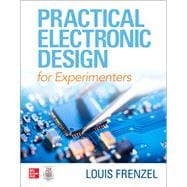- Introduction
- 1 Introduction to Electronic Design
- Defining Design
- Design Perspective
- Get a Design Notebook
- Get a Calculator
- A Standard Design Approach
- Design Doctrine Dozen
- Types of Design
- Prerequisites for Design
- A Design Example
- An Alternative Beginning
- 2 Design Resources
- Books
- Sources of Catalogs, Components, and Equipment
- Magazines
- Data Sheets
- Applications Notes
- Useful Web Sites
- Educational Sources
- Back to Basics
- Searches
- 3 Simulation and Prototyping
- Circuit Simulation
- Recommendation
- Breadboarding
- Dead Bug Method
- Working with Surface-Mount Components
- Components
- One Good Prototyping Practice
- A Workbench
- Summarizing
- A Word About Tools
- Your Projects
- 4 Testing and Measuring
- Multimeters
- How to Use a Multimeter
- Power Supply
- Oscilloscopes
- Function Generators
- Virtual Instruments
- Circuits for Testing
- Power Supply
- Signal Sources
- Making L and C Measurements
- 5 Common Circuit Design Techniques
- Drawing Circuits
- Series-Dropping Resistor
- Voltage Dividers
- Special Sensor Resistors
- Potentiometers
- Error and Accuracy
- Variable Voltage Dividers
- Transistor Switches
- Design Example 5.1
- Design Example 5.2
- Design Project 5.1
- Design Project 5.2
- Design Project 5.3
- Design Project 5.4
- Design Project 5.5
- 6 Power Supply Design
- Power Supply Choices and Specifications
- The Make vs. Buy Decision
- Common Voltages
- Designing a Battery Supply
- Ampere-Hour Ratings
- Battery Supply Design Procedure
- Battery Supply Enhancements
- Specifying a Linear Supply
- Linear Supply Design Procedure
- Linear Supply Design Example
- Switch-Mode Power Supplies (SMPS)
- Pulse-Width Modulation
- Design Project 6.1
- Design Project 6.2
- Design Project 6.3
- Design Project 6.4
- 7 Amplifier Design
- Amplifier Types
- Specifying Amplifiers
- Understanding the Specifications
- A Microphone Amplifier
- Designing with Op Amps
- Primary Op Amp Application Circuits
- Differential Amplifier
- Error Source Compensation
- Comparators
- Power Amplifiers
- Design Projects
- Design Project 7.1
- Design Project 7.2
- Design Project 7.3
- Design Project 7.4
- 8 Signal Source Design
- Signal Source Specifications
- Sine Wave Oscillators
- Clock Oscillators
- Multivibrators
- Frequency Synthesizers
- Design Project 8.1
- Design Project 8.2
- Design Project 8.3
- Design Project 8.4
- Design Project 8.5
- Design Project 8.6
- 9 Filter Design
- Types of Filters
- Filter Specifications
- Filter Design Guidelines
- Filter Response Options
- RC Filter Design
- Bandpass LC Filters
- Band Reject Filters
- RC Active Filters
- Low-Pass Filter
- LC Filter Design
- Switched Capacitive Filters
- DSP Filters
- Design Project 9.1
- Design Project 9.2
- Design Project 9.3
- Design Project 9.4
- 10 Electromechanical Design
- Switches
- Relays
- Solenoids
- Motors
- Motor Control
- Servo Motors
- Design Project 10.1
- Design Project 10.2
- Design Project 10.3
- 11 Digital Design
- Three Design Approaches
- Preliminary Design Decisions
- Combinational Logic Circuits
- DeMorgan’s Theorem
- Functional ICs
- Practical Digital Design Procedures
- Design Example
- Designing with a Programmable ROM
- TTL vs. CMOS
- Sequential Logic Circuits
- Flip Flops
- Counters and Registers
- State Machine Design
- Design Example
- Data Conversion
- Data Conversion ICs
- Design Project 11.1
- Design Project 11.2
- Design Project 11.3
- Design Project 11.4
- Design Project 11.5
- Design Project 11.6
- Design Project 11.7
- Design Project 11.8
- Design Project 11.9
- 12 Programmable Logic Devices (PLDs)
- Programmable Logic Types
- Programming PLDs
- Complex Programmable Logic Devices
- FPGA Dominance
- Application Decisions
- An Introduction to VHDL and Verilog
- Development Boards
- Coding the Digital Circuit with an HDL
- FPGA Learning Resources
- Development Board Sources
- Summary
- 13 Designing with Microcontrollers
- Embedded Controller Design Process
- Choosing an MCU and the Software
- More About Selecting an MCU or Processor
- Software and Programming
- Programming Language Examples
- Some Takeaways
- Learning to Love BASIC
- The Case for Assembly Language
- Microdesign Considerations
- Microinterfacing
- A Plan for Learning Micros
- Committing to a Microfuture
- Design Project 13.1
- Design Project 13.2
- Design Project 13.3
- 14 Component Selection
- Resistors
- E-24 Resistor Values—5 percent
- E-96 Resistor Values—1 percent
- Special Resistors
- Potentiometers
- Capacitors
- Inductors
- Semiconductor Selection
- 15 Troubleshooting and Debugging
- Mitigating the Need for Hardware Troubleshooting
- Test Equipment
- Prototype Troubleshooting
- Electrical Problems
- Troubleshooting Procedures
- Component Failure Likelihood
- A Troubleshooting Example
- Continuity Testing
- General Troubleshooting Suggestions
- Software Debugging
- Troubleshooting Practice
- A Recommended Reference Books
- B Solutions to Design Projects
- C Transistor Amplifier Design
- D How to Use Karnaugh Maps
- Index








